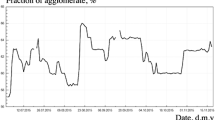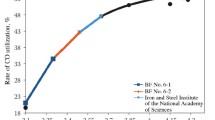Equipping blast furnaces with bell-less top (BLT) chargers is intended for reducing the consumption of costly and scarce coke, as well as increasing the productivity of blast furnaces. However, equipping a furnace with BLT charger does not always lead to achieving these goals. In a number of cases, the result is opposite. This made a number of researchers doubt the feasibility of further installation of bellless top charging equipment on blast furnaces. The experience of operating the bell-less top charger showed that a simple replacement of a double-bell charger with bell-less top one does not produce an improvement in blast-furnace process parameters, such as a decrease of coke consumption and increase in productivity. A bell-less top charger is just a management tool that can be used to achieve this goal. But like with all other tools, it is important to learn how to use it. For this purpose, it is important to provide a blast furnace with the evaluation and control means to manage the distribution of the charge materials along the furnace throat radius and utilization of thermal and chemical energy of the gas flow. The distribution of the charge materials along the furnace throat radius is associated with the variation in ore charge (ore-to-coke (O/C) ratio). Different values of the O/C ratios along the furnace throat radius play an important role in the formation of a gas flow inside the blast furnace. A mathematical model is proposed to be used as a tool for estimating the optimal distribution of the ore charge along the furnace radius based on the zonal balances of the blast-furnace process. Such model was used to analyze the study results related to the effect of the O/C ratio variation along the furnace throat radius on a decrease in coke consumption and increase in productivity of the blast furnaces operating in Japan and Russia. A satisfactory agreement between the calculated and actual results allows recommending such mathematical model for preliminary calculation of the optimal distribution of ore charge along the radius of the blast furnace. This makes it possible to calculate the bell-less top charging systems, as well as identify the furnace zones with unsatisfactory utilization of thermal and reduction energy of the gas flow.




Similar content being viewed by others

References
V. P. Tarasov, P. V. Tarasov, and L. V. Bykov, “On the performance of blast furnaces equipped with bell-type and bell-less top chargers,” JSC “Chermetinformatsiya,” Bulletin “Chernaya Metallurgiya,” No. 3, 11–15 (2007).
J. Kurihara, S. Hashizume, H. Takahashi, and H. Marushima, “Low fuel rate operation of blast furnace — test operation with 100% agglomerated ore,” Kawasaki Steel Technical Report, 12, 157–163 (1980).
V. A. Dobroskok, Software-controlled Measurement Diagnostic Complex for Metallurgic Shaft Furnaces, Doc. Sci. (Eng.) Dissertation (ext. abst.), Moscow (1994).
V. I. Bolshakov, I. G. Muravyeva, and Yu. S. Semenov, Application of Radar Systems for Measuring Stockline Area to Monitor and Control a Blast-Furnace Process [in Russian], Porogi, Dnepropetrovsk (2013).
V. P. Tarasov, P. V. Tarasov, and L. V. Bykov, “Gas-dynamic parameters and indicators of furnace performance when utilizing bell-type and bell-less top chargers,” Stal, No. 1, 6–10 (2005).
A. V. Pavlov, Improvement of Blast-Furnace Smelting Technology by Using Model Decision-Making Support Systems, Cand. Sci. (Eng.) Dissertation, Magnitogorsk (2016).
S. P. Rogozhnikov, A. V. Kartashov, I. P. Manaenko, and N. S. Shtafienko, “Effect of a number and diameter of air tuyeres on the blast-furnace performance,” Metallurg, No. 11, 22–24 (1986).
N. N. Babarykin and S. P. Rogozhnikov, “Determining coke consumption during a blast-furnace process,” in: Proizvodstvo Chuguna, Sverdlovsk, 49–64 (1982).
N. N. Babarykin, S. P. Rogozhnikov, and A. V. Kartashov, “Determining coke consumption during a blast-furnace process based on the hearth temperature. Pt 1,” Izv. Vuzov, Chernaya Metallurgiya, No. 12, 18–21 (1986).
N. N. Babarykin, S. P. Rogozhnikov, and A. V. Kartashov, “Determining coke consumption during blast-furnace smelting based on the hearth temperature. Pt 2,” Izv. Vuzov, Chernaya Metallurgiya, No. 2, 24–27 (1987).
N. N. Babarykin, Theory and Technology of the Blast-Furnace Process, Monograph [in Russian], GOU VPO MGTU, Magnitogorsk (2009).
I. G. Tovarovskii, V. I. Bolshakov, and A. Ye. Merkulov, Analytical Study of the Blast-Furnace Processes [in Russian], Ekonomika, Dnepropetrovsk (2011).
K. Okumura, T. Kawai, H. Maruahima, H. Takahashi, and J. Kurihara, “Lower fuel rate operation by a large blast furnace equipped with bell-less top,” Tetsu-to-Hagane, 13, 1956–1965 (1980).
R. S. Takhautdinov, V. I. Sedinkin, A. L. Mavrov, and A. V. Pavlov, “Technological aspects of operating blast furnaces with bellless top chargers,” Stal, No. 11, 15–17 (2008).
Author information
Authors and Affiliations
Corresponding author
Additional information
Translated from Metallurg, Vol. 63, No. 10, pp. 28–33, October, 2019.
Rights and permissions
About this article
Cite this article
Rogozhnikov, S.P., Rogozhnikov, I.S. Mathematical Model for Estimating the Optimal Distribution of Ore Charge Along the Blast Furnace Radius Based on Zonal Balances. Metallurgist 63, 1024–1032 (2020). https://doi.org/10.1007/s11015-020-00921-0
Received:
Published:
Issue Date:
DOI: https://doi.org/10.1007/s11015-020-00921-0



